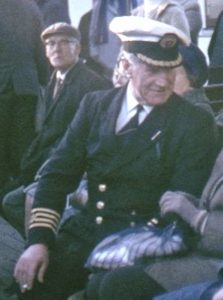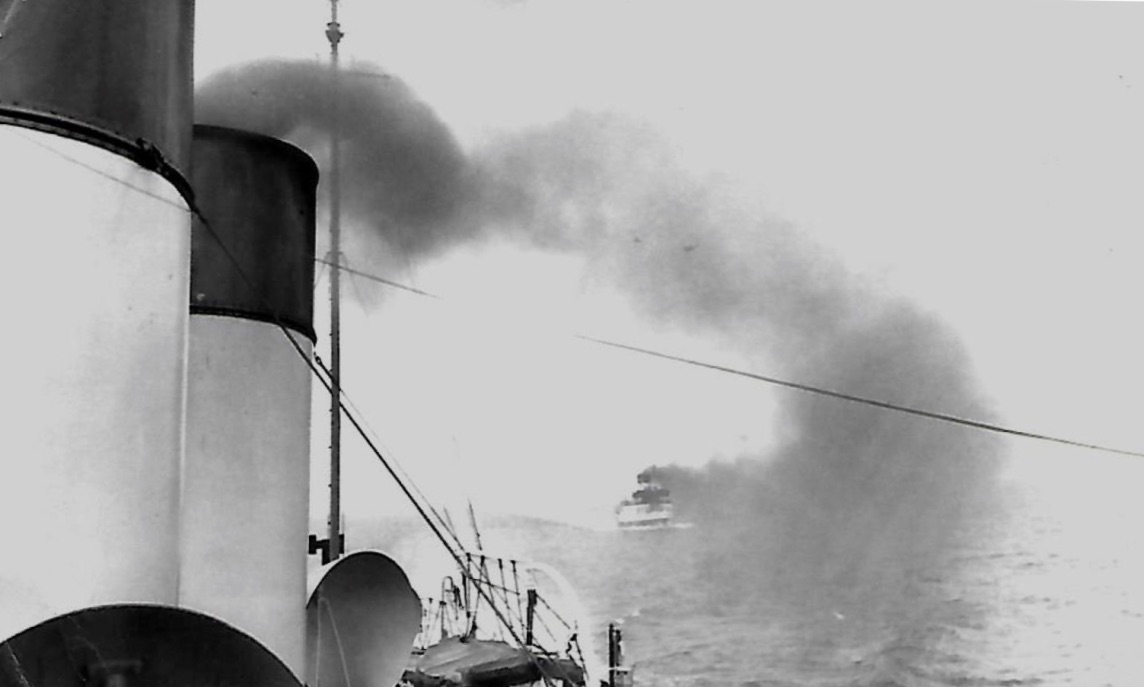
View from the port bridge wing: Duchess of Hamilton leads Duchess of Montrose across the Firth on one of their legendary Friday morning races from Rothesay to Largs in 1964. Captain Fergus Murdoch was Master of the ‘Hamilton’ from 1946 to 1967. Copyright CRSC/Andy Logan
A Scot who emigrated to Canada in the mid 1960s, Andy Logan had a distinguished career on deep sea ships and cross channel ferries, but he has never forgotten his three years as a young bridge officer on the Clyde steamers.
Growing up in the village of Sandbank on the Holy Loch I became something of a steamer fan. Frequent visits to my father’s relatives in Glasgow involved sailing on various vessels, with routine visits to watch the steam reciprocating engines driving the paddles. I have a faint memory of taking one of the last sailings from Ardnadam Pier before it closed for use by the navy to service their vessels based there, including the submarine depot ship HMS Forth.

Andy Logan (right) as Mate of Duchess of Hamilton in 1964. The photo was taken during a charter for Hamilton and Coatbridge pensioners, the oldest of whom was given a shot at the wheel. In 1965 Andy emigrated to Canada, and by the time he retired in 1998, he had captained numerous ferries on the coast of British Columbia. He was born at Sandbank on the Holy Loch
Later I went to sea as an apprentice. I studied at the James Watt College and sailed on many ocean voyages with the Clan Line as a deck officer. After my marriage I became disillusioned with ‘life on the ocean wave’ and the many months away from home that it involved.
In March 1962, while travelling from Dunoon to Glasgow to join a Clan Line vessel, and on an impulse, I went in to the Caledonian Steam Packet Company headquarters on Gourock Pier to enquire about job prospects. I left the office with an offer of a position as Mate for that summer.
While working out my notice with Clan Line and on their vessel Argyllshire in Glasgow, I noticed Queen Mary II under repair nearby. I walked along the dock and boarded her. It was my good fortune to meet up with the Mate, Duncan McTavish. An affable man with a seafaring background much like my own, he welcomed me to the CSP and gave me some valuable tips.
Soon after, I was assigned to Maid of Ashton. This suited me really well as she berthed overnight at Kilmun. I purchased a motorcycle so that I could commute from my home in Dunoon. I had a few days of familiarisation with her Mate, Alistair McDonald, a really helpful man. One piece of advice he gave me was that I might see some of the ways they did things on the Clyde vessels as strange, but I would later find that there was a good reason for it. I took this to heart and indeed it worked out just as he said.
My first Captain was Hector McKenzie. In poor health, he delegated a great deal of the vessel docking to me, especially in high winds when his emphysema acted up. This was on a vessel that sometimes made 18 or more pier calls a day. Of course, as a young Mate I had an abundance of confidence and enjoyed the challenge. Experience in handling that vessel was to stand me in good stead for the rest of my career.
There were some interesting experiences on the ‘Ashton’. One was when the vessel was chartered by the Scottish Office to take a Russian aviation delegation from Gourock to Tighnabruaich. They were hosted by the aviation minister of the day and Sir Fitzroy McLean. The vessel was taken off the run and spruced up for the job.

‘Some of the ways they did things on the Clyde were strange, but there was good reason for it’: Maid of Ashton at Gourock c1963. Andy Logan served on her as Mate on the Holy Loch and Millport runs. Copyright CRSC David Landale Collection
The Russians included the son of Nikita Khrushchev, the Soviet Communist Party leader, and the famous aircraft designer Sergey Ilyushin. Unfortunately the weather on the big day was deplorable, with high winds and torrential rain. The scenic cruise through the Kyles of Bute was a flop as the shore line was barely visible. Arriving at Tighnabruaich they were to be escorted to Sir Fitzroy’s estate at Strachur by the Dunoon Police, who were nowhere to be seen. After a long delay they finally showed up. On disembarking it could be seen that there had been great enjoyment of the refreshments down below in the lounge. The crew enjoyed an excellent meal later that day with the left-over food.
The ‘Ashton’ would spend part of the winter on the Largs-Millport run, a duty not always looked forward to by the crew. Millport was not a safe overnight berth in high southerly winds. Often we had to head to Rothesay from Millport when the forecast was bad. This meant a long day with a very late finish in Rothesay, and an early start to head back to Millport for the early morning sailing.
I remember being on that run with Captain Donald Crawford. He was a somewhat flamboyant man who, when passing another company vessel, would whip a handkerchief out of his sleeve with a great flourish and wave it back and forth to the passing ship. Several times in nice weather entering Millport he would remark “Isn’t this a delightful spot, Andy?” On another occasion in high winds, with the seas crashing on the rocks at the entrance to Millport Bay, he would exclaim “What a **** wee hole this is.”
Maid of Ashton was regularly used as the passenger tender for large liners anchored at the Tail of the Bank. These included the Canadian Pacific ‘Empresses’ and Cunard ships Carinthia and Ivernia. It wasn’t always an easy task for the Master due to the anchored liner swinging away or towards the vessel when coming alongside. However, it made for a pleasant change from the normal routine.
There was a sailing from Hunter’s Quay to Gourock around 1640. We normally picked up a large number of American sailors there. On one occasion as we were approaching Hunter’s Quay we saw that the large US Navy liberty boat had run aground off the north side of the pier. After tying up the ‘Ashton’ securely, we got a line to the liberty boat and pulled it off with the aft winch.
It was a happy bunch of sailors who clambered up the side ladder on the pier and boarded the ‘Ashton’. Later, the commanding officer of the US Holy Loch submarine base sent the CSP a very appreciative letter, which was copied to our Master that day, Captain Hector Connell, an exceedingly cordial man from Dunoon.
On first joining the ‘Ashton’ I had a troublesome time with the pilot, John Ferguson. He had worked on the run for about 40 years and seemed difficult. Other Mates knew of this and would commiserate with me. With the passage of time this changed: we became good shipmates.
I spent some winter periods on the three ABC car ferries. During 1963 and on time off I had a call from Gourock to join Jeanie Deans for a day or two. I pointed out that I hadn’t worked on a paddler. They usually kept such vessels for those familiar with them. They told me I was the only Mate available. So I did join her and it all worked out fine with some guidance. Those vessels were not highly manoeuvrable and needed lots of room to turn.
On the first day, when it came near time to sail from Tighnabruaich, I switched on the radar. There was a heavy drizzle with limited visibility. The radar wouldn’t function properly and the Captain said I should ask the engineers to improve the electrical voltage. The engineer said he would and I found later that he pulled the breaker on some of the passenger area lighting. Much new equipment had been added and the old generators were not designed for the additional load.
In the spring of 1964 I was surprised to be assigned to Duchess of Hamilton. I knew that I couldn’t stay on Maid of Ashton for ever and thought I might be sent to a car ferry. Captain Fergus Murdoch had a lot of influence and could get any Mate he wanted, so it was a little flattering. I had worked with him a number of times during the winters and knew him quite well. I can say that I had a happy summer there. He could be quite the practical joker. Once on the way to Ayr, my wife boarded at Dunoon. He informed her that he had told me to disembark at Dunoon the previous evening, but that I had told him I would rather go to Cappielow to see Morton playing. Quite untrue, of course, and I had a bit of explaining to do.
On another occasion, the joke was inadvertently of my own making. We had left Brodick bound for Ayr. I had just taken over the watch from Captain Murdoch and noted what I took to be the fin of a basking shark on the port bow. I mentioned this to Fergie and he said I should announce it for the passengers. On doing so, many hurried to the port side and we took a port list. A few moments later, after carefully studying the scene with the binoculars, to my horror I realised it was a large paint can! Captain Murdoch told me later that a passenger stopped him on the deck to enquire the whereabouts of the basking shark. For the rest of my career I made a point of double-checking before making such announcements.
Fergie didn’t delegate much of the ship handling — I couldn’t say that he was a great teacher — but he was an expert ship handler and much could be learned from observing. He was very good, for example, at working the tide and wind.
He was a pleasant and cheerful man to work with, but there was a story that one Mate had made a hard landing, breaking a window back aft. The rumour went that, as a result of this, Fergie had given the Mate a left hook. I didn’t know if this was fact. Anyway, I was very careful!
On a subsequent visit to Ayr, a relief Captain was in charge, and he decided to go in astern. There was insufficient room at Ayr Harbour to turn the ship round, so you either had to enter or leave stern-first. The ‘Hamilton’, which had been built in 1932 as Ayr excursion steamer, had a bow rudder to facilitate this. Orders were sent by the docking telegraph to the two seamen on the wheel forward. There was a fresh wind blowing and something didn’t go right. The vessel landed heavily amidships on the north pier at the entrance. I hurried to the engine room to see if there was any hull damage and I was able to tell the relief Captain that the only damage was to the rubbing strake.
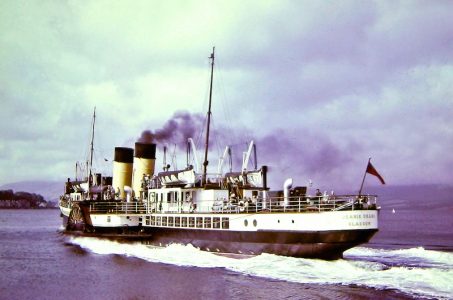
‘Everyone knew Jeanie Deans’ days were numbered’: bad morale in the Clyde fleet in the mid 1960s was one of the factors prompting Andy Logan to seek his fortune elsewhere. Copyright CRSC
After tie-up, I found him looking over at the damage and I thought he would be worried about reporting it to the office. To my surprise he said “What is Fergie going to say?” Captain Murdoch had served on the ‘Hamilton’ for so many years, and the ship was definitely regarded as his own.
Fergie commanded a lot of respect in the fleet — he was quite a firm person when he thought it was required, especially with the seamen. One morning before sailing he told me that he was unhappy with the way the seamen were maintaining their ‘croft’. The deck crew were divided into ‘crofts’ with each seaman assigned to one. He wanted me to chastise them and tell them to improve. This rightly should have been the pilot’s job but I didn’t argue. It was quite intimidating for me, a very youthful looking 28-year-old Mate, to assemble all these ancient mariners. I did follow instructions — but I took the coward’s way out by telling them the Captain had told me.
There was some rivalry between the two ‘Duchesses’, the ‘Montrose’ and the ‘Hamilton’. On one particular Friday at Rothesay pier we were bow to bow. Both had the same sailing time and both were crossing to Largs (the ‘Montrose’ going on to Campbeltown, the ‘Hamilton’ to Ayr). The ‘Montrose’ cheated by letting go a minute early and swinging her bow out, so that the ‘Hamilton’ was blocked till she had cleared. Then the ‘Hamilton’, belching black smoke, got going and we overtook the ‘Montrose’ — but disaster almost struck when steam pressure on the ‘Hamilton’ went down and the ‘Montrose’ slowly drew ahead. There was consternation and hurried action in the boiler room, and the pressure eventually came back up. The ‘Hamilton’ slowly drew ahead, saving the day.
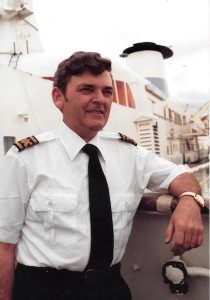
Captain Andy Logan on BC Ferries’ Queen of the North, on which he served as Master in the 1980s and 1990s
These ‘Caley’ turbines were very comfortable ships. They ran so smoothly and quietly. They were of original design and direct drive. In other words, the propeller shaft came right out of the turbine. Some other turbine vessels (such as King George V) had a reduction gear to drive the propeller more slowly. This was more economical but created considerable noise.
I had spent a little time in 1946 in Canada, crossing the Atlantic on RMS Queen Mary. I loved Scotland and the Firth of Clyde very dearly, but there was always a thought at the back of my mind that I’d like to go back to Canada. On the Clyde there were depressing conversations about which vessel would be disposed of next. Everyone knew Jeanie Deans’ days were numbered and perhaps even the ‘Montrose’.
I resigned from the CSP in early 1965 and emigrated to Canada. I soon got a position with British Columbia Ferries, becoming a relief Master on their largest vessels in the spring of 1967, with a permanent appointment soon afterwards. I retired in 1998. There is no doubt that my time on the Firth of Clyde on the CSP boats, and the help I received from many shipmates there, stood me in good stead on the much larger BC Ferries.
I had corresponded with Fergie from Vancouver and on my first trip back to Scotland with my family I took a taxi from Prestwick to Gourock. On pulling on to the pier the first person I saw was Captain Murdoch. He had retired but was working as Mate on the Dunoon ferry. I had a happy crossing to Dunoon with him.
Another Master I worked with frequently was Callum Maclean from Blairmore — a nice man. He was a former LNER man and regularly worked summers on the paddlers. A few years after emigrating, I was on Queen of Alberni and got a radio call from the ferry behind us, asking if I could recognise the person they put on the radio. I knew immediately who it was, and met Callum and his wife and took them home for dinner. We had a very nice time together.
A number of years ago, on a visit to Sandbank, I took a trip on Waverley from Dunoon to Blairmore and Loch Goil. After returning to Dunoon that day I met Roddy Murray on the pier. He and I had joined the CSP in the same season. We had a brief but happy meeting. I’m very grateful for the experiences I had on the CSP boats, and to this day I reminisce about my times there.
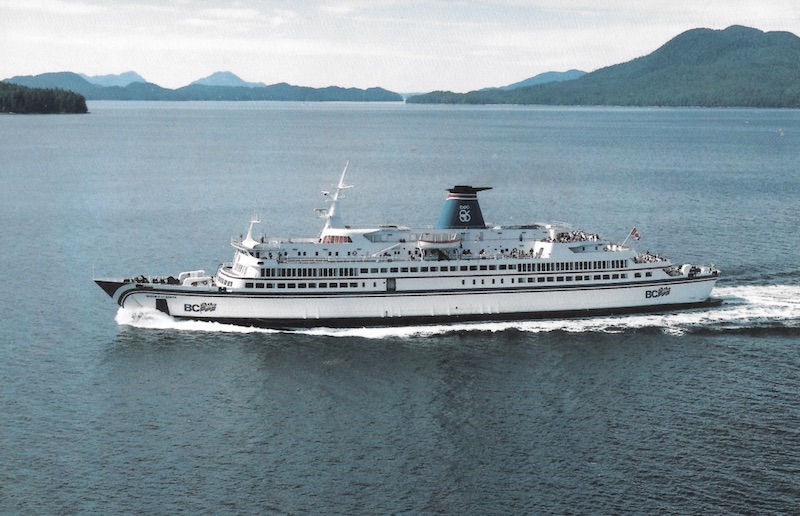
Queen of the North was one of the many vessels captained by Andy Logan on the British Columbia coast. Some years after he retired she ran aground during an inside passage up north, and became a total loss

Bow to bow: the two ‘Duchesses’ at Dunoon, with the ‘Montrose’ nearest the camera. Copyright Ian Milne
Join CRSC now for £10 and receive all the benefits.
To receive occasional newsletters from CRSC by email, subscribe to our mailing list.
Published on 14 October 2018












